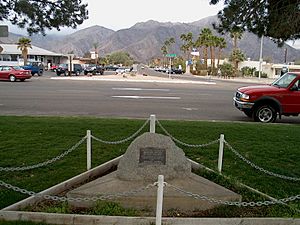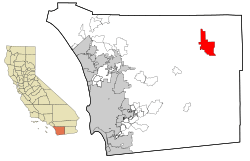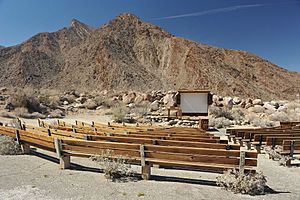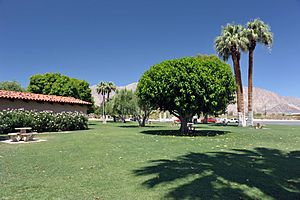Borrego Springs, California facts for kids
Quick facts for kids
Borrego Springs, California
|
|
|---|---|

Downtown as seen from Christmas Circle
|
|

Location in San Diego County and the state of California
|
|
| Country | |
| State | |
| County | San Diego |
| Area | |
| • Total | 43.41 sq mi (112.42 km2) |
| • Land | 43.41 sq mi (112.42 km2) |
| • Water | 0.00 sq mi (0.00 km2) 0.78% |
| Elevation | 597 ft (182 m) |
| Population
(2020)
|
|
| • Total | 3,073 |
| • Density | 70.80/sq mi (27.33/km2) |
| Time zone | UTC−8 (PST) |
| • Summer (DST) | UTC−7 (PDT) |
| ZIP code |
92004
|
| Area codes | 442/760 |
| FIPS code | 06-07596 |
| GNIS feature IDs | 1652675, 2407888 |
Borrego Springs is a special community in northeastern San Diego County, California. The name borrego means "sheep" in Spanish. This area is known for being completely surrounded by Anza-Borrego Desert State Park. In 2020, about 3,073 people lived here.
Contents
A Look Back: History of Borrego Springs
The name of Anza-Borrego Desert State Park comes from two things. One is Juan Bautista de Anza, an explorer who camped in the area long ago. The other is "borrego," which is Spanish for "lamb." This honors the wild bighorn sheep that live nearby.
During World War II, the area east of Borrego Springs was a huge training center for the US Navy. It was called the Borrego Valley Maneuver Area. There were camps and airstrips for training soldiers.
Nature and Surroundings
Borrego Springs is located in the Borrego Valley. This valley is on the western edge of the Sonoran Desert ecoregion. The town and its surroundings are home to many different desert plants and animals.
One special plant you can find here is the California Fan Palm. Its scientific name is Washingtonia filifera. This is the only type of palm tree that grows naturally in the western United States. It is considered a near-threatened species. There's also an old calcite mine from World War II in the nearby Santa Rosa Mountains.
Weather in Borrego Springs
Borrego Springs has a very hot and dry desert climate. It gets very little rain. On average, there are over 176 days each year when the temperature reaches 90°F (32°C) or higher. It rarely gets very cold, with only about one day a year dropping to 32°F (0°C) or lower.
The hottest temperature ever recorded was 122°F (50°C) in June 1990. The coldest was 20°F (-7°C) in January 1971. On average, the area gets about 5.21 inches (132 mm) of rain each year. Snow is very rare in the low areas, but 6.5 inches (17 cm) fell in December 1967.
| Climate data for Borrego Springs, California 1991–2020 normals, extremes 1965–present | |||||||||||||
|---|---|---|---|---|---|---|---|---|---|---|---|---|---|
| Month | Jan | Feb | Mar | Apr | May | Jun | Jul | Aug | Sep | Oct | Nov | Dec | Year |
| Record high °F (°C) | 90 (32) |
95 (35) |
101 (38) |
111 (44) |
114 (46) |
122 (50) |
121 (49) |
120 (49) |
117 (47) |
113 (45) |
98 (37) |
89 (32) |
122 (50) |
| Mean maximum °F (°C) | 80.2 (26.8) |
83.3 (28.5) |
91.7 (33.2) |
100.5 (38.1) |
105.8 (41.0) |
113.5 (45.3) |
116.5 (46.9) |
115.1 (46.2) |
110.6 (43.7) |
102.1 (38.9) |
89.8 (32.1) |
79.1 (26.2) |
117.6 (47.6) |
| Mean daily maximum °F (°C) | 69.7 (20.9) |
72.3 (22.4) |
79.0 (26.1) |
85.3 (29.6) |
93.2 (34.0) |
102.9 (39.4) |
107.4 (41.9) |
106.8 (41.6) |
101.1 (38.4) |
90.2 (32.3) |
77.9 (25.5) |
68.5 (20.3) |
87.9 (31.1) |
| Daily mean °F (°C) | 57.6 (14.2) |
59.8 (15.4) |
65.3 (18.5) |
70.5 (21.4) |
77.7 (25.4) |
86.2 (30.1) |
92.3 (33.5) |
92.1 (33.4) |
86.4 (30.2) |
76.0 (24.4) |
64.9 (18.3) |
56.8 (13.8) |
73.8 (23.2) |
| Mean daily minimum °F (°C) | 45.5 (7.5) |
47.4 (8.6) |
51.7 (10.9) |
55.7 (13.2) |
62.2 (16.8) |
69.5 (20.8) |
77.1 (25.1) |
77.5 (25.3) |
71.7 (22.1) |
61.8 (16.6) |
51.9 (11.1) |
45.0 (7.2) |
59.8 (15.4) |
| Mean minimum °F (°C) | 34.4 (1.3) |
36.8 (2.7) |
39.6 (4.2) |
44.4 (6.9) |
49.5 (9.7) |
56.6 (13.7) |
67.0 (19.4) |
66.3 (19.1) |
58.9 (14.9) |
50.2 (10.1) |
40.2 (4.6) |
34.4 (1.3) |
31.7 (−0.2) |
| Record low °F (°C) | 20 (−7) |
24 (−4) |
28 (−2) |
28 (−2) |
34 (1) |
45 (7) |
56 (13) |
55 (13) |
49 (9) |
33 (1) |
31 (−1) |
23 (−5) |
20 (−7) |
| Average precipitation inches (mm) | 1.16 (29) |
1.24 (31) |
0.62 (16) |
0.18 (4.6) |
0.05 (1.3) |
0.01 (0.25) |
0.25 (6.4) |
0.32 (8.1) |
0.15 (3.8) |
0.20 (5.1) |
0.22 (5.6) |
0.81 (21) |
5.21 (132.15) |
| Average precipitation days (≥ 0.01 in) | 4.0 | 4.1 | 3.1 | 1.4 | 0.7 | 0.1 | 1.1 | 1.2 | 1.0 | 0.7 | 1.4 | 3.4 | 22.2 |
| Source: NOAA | |||||||||||||
Who Lives Here?
| Historical population | |||
|---|---|---|---|
| Census | Pop. | %± | |
| 1990 | 2,244 | — | |
| 2000 | 2,535 | 13.0% | |
| 2010 | 3,429 | 35.3% | |
| 2020 | 3,073 | −10.4% | |
| U.S. Decennial Census 1850–1870 1880-1890 1900 1910 1920 1930 1940 1950 1960 1970 1980 1990 2000 2010 |
|||
In 2020, the population of Borrego Springs was 3,073 people. The community has grown over the years. Many people who live here are older adults, and some families with children also call Borrego Springs home.
Fun Things to Do
Borrego Springs has different styles of buildings, like pueblo-style homes and modern designs. A well-known spot is Christmas Circle, a traffic roundabout in the center of town. You can find a local library branch here too.
Since Anza-Borrego Desert State Park surrounds the town, there are many outdoor activities. You can enjoy four public golf courses, a tennis center, and horseback riding. Many visitors, especially "snowbirds" (people who travel to warmer climates in winter), come to Borrego Springs. Tourism is a very important part of the town's economy.
Borrego Springs is also special because it's an International Dark Sky Community. This means the town works hard to keep its night sky dark and clear. There are no stoplights, and outdoor lights are kept dim. This helps everyone see the stars and planets much better! It's a great place for stargazing and astronomy events throughout the year.
Air Shows and Art
Near the Borrego Valley Airport, there's a special area for aerobatic pilots. These pilots perform amazing tricks and stunts in their planes. They use this area for practice and competitions. You can often watch them fly, especially during the two annual events in April and October.
Another unique attraction is Galleta Meadows Estate. Here, you can find over 130 huge metal sculptures of animals. These amazing artworks were created by sculptor Ricardo Breceda. They are spread out across the desert landscape, making for a fun scavenger hunt!
Images for kids
See also
 In Spanish: Borrego Springs para niños
In Spanish: Borrego Springs para niños







